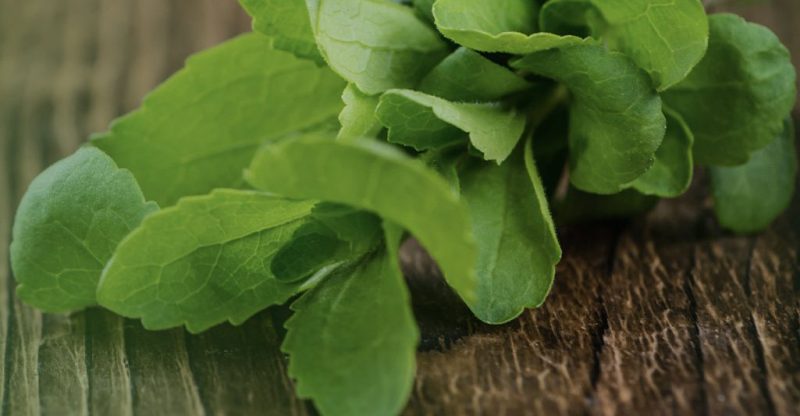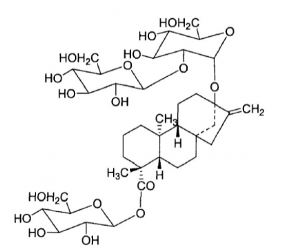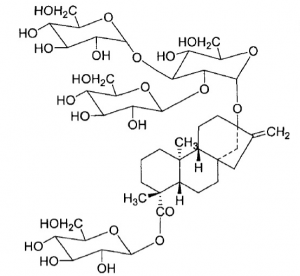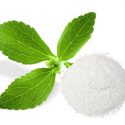What is Stevioside (E960): Extraction, Compare Reb A, Uses, Safety

Production | Comparison with Rebaudioside A | Uses | Safety
Stevioside or stevia extract, a high intensity sweetener extracted from leaves of stevia rebaudiana bertoni with the European food additive number E960. It is the major component in steviol glycosides, which accounts for 60-70% in total steviol glycosides.
This sugar alternative can also be used to replace or combine with artificial sweeteners in food & beverage.
How to Extract Stevioside?
Generally, stevioside is produced from stevia leaves through a series of purification processes such as precipitation, extraction, decolorization, and spray-drying. The following manufacturing process was from the Canada manufacturer, GLG Life Tech. (1)
Dried stevia leaves are subjected to purified water first. Then followed by a precipitation process with ferric chloride and calcium hydroxide to remove non-soluble plant materials & other impurities and follow filtration.
Then the leaf extract goes through an adsorption resin, which is used to trap the steviol glycosides of the leaf extract.
Afterward, wash the resin with ethanol to release steviol glycosides and decolorize the resulting solution with activated carbon to remove the colors in leaves, and then concentrated by evaporation.
Again, go through the process of decolorization, filtration and spray-drying. The spray-dried product is then combined with similarly processed additional extracts, dissolved in ethanol and/or methanol, crystallized and filtered. Finally, after further processes of crystallization, filtered and spray-dried to obtain pure stevioside.
Property
| Other names | Stevia leaf extract, Stevia sweetener |
| CAS number | 57817-89-7 |
| Chemical formula | C38H60O18 |
| Molecular weight | 804.88 |
Appearance
A white to off-white hygroscopic powder.
Taste
250–300 times sweeter than sucrose and the sweet taste can last for a long time in the mouth, but with a significant bitterness and undesirable aftertaste, which limits its uses at high concentrations.
Stability
The sweetness can be maintained even though heated for 2 hours at 100 ℃ over a pH range from 3-9. Meanwhile, it is stable (also with reb-A) in carbonated phosphoric and citric acidified beverages at room temperature. (2)
Solubility
Sparingly soluble in water (0.12%) at room temperature, freely soluble in ethanol.
Synergy
Having a sweet synergistic effect with artificial sweeteners, such as aspartame and acesulfame-K.
What is the difference between Stevioside and Rebaudioside A?
Stevioside and rebaudioside A are two major natural sweeteners in the leaves of the stevia plant. They have the same based structure steviol but the latter has one more glucose moiety, which leads to their difference.
- Stevioside
- Rebaudioside A
The following are the two main comparisons:
- Water solubility: rebaudioside A is more soluble in water, with the solubility 1%.
- Sweet taste and Uses: reb A is more sweeter than stevioside, without significant bitterness, and used widely than stevioside. Reb A was considered as the best tasting commercial stevia, but later came rebaudioside M (reb M).
What’re the Uses of Stevioside?
Stevioside was first isolated and used in low/free sugar and reduced-calorie food & drink among other steviol glycosides. With the benefits of natural plant based, zero calorie, does not raise blood sugar (safe for diabetics).
With an emphasis on decreasing calorie intake and sugar consumption, and preferring natural high intensity sweeteners, some food and drink manufacturers change from the use of artificial sweeteners to stevia sweeteners and monk fruit sweeteners.
When used as a sugar substitute, only a small amount of stevioside is needed to achieve the desired sweetening purposes due to its about 250-300 times sweeter than table sugar.
However, its uses are not wide as reb A due to its unpleasant taste.
The following food may contain with stevioside:
- Tabletop sweeteners
- Sweetened teas
- Fruit juice drinks
- Diet soft drinks
- Energy drinks
- Flavored water
- Pickled vegetables
- Soy sauce
- Cereals
- Candies
- Chewing gum
- Yogurt
- Ice cream
It can be used to sweeten confectionery for children as it’ll not promote tooth decay and does not affect blood sugar levels. It is also suitable for cooking and baking as it is heat stable.
In pharmaceuticals, stevioside can also be used to replace sugar in lozenges; in personal care products, it can be used in toothpaste as a sweetening agent which is tooth friendly.
Is it Safe to Eat Stevioside?
High-purity (95% minimum) of individual or combined steviol glycosides can be considered as GRAS (Generally Recognized as Safe) by the FDA. (3)
For example, FDA had no questions regarding GLG Life Tech’s conclusion that stevioside (≥95% by weight (w/w)) is GRAS as a general-purpose sweetener in foods or as a table top sweetener, except uses in meat, poultry products and infant formulas. (4)
Conclusion
Now you may have a knowledge of the steviol glycoside – stevioside (E960), from the following aspects:
- Extraction process
- Property
- Uses
- Compared with rebaudioside A
- Safety
What kinds of food labels have you found stevioside, reb A or M in? Let me know in the comments.




